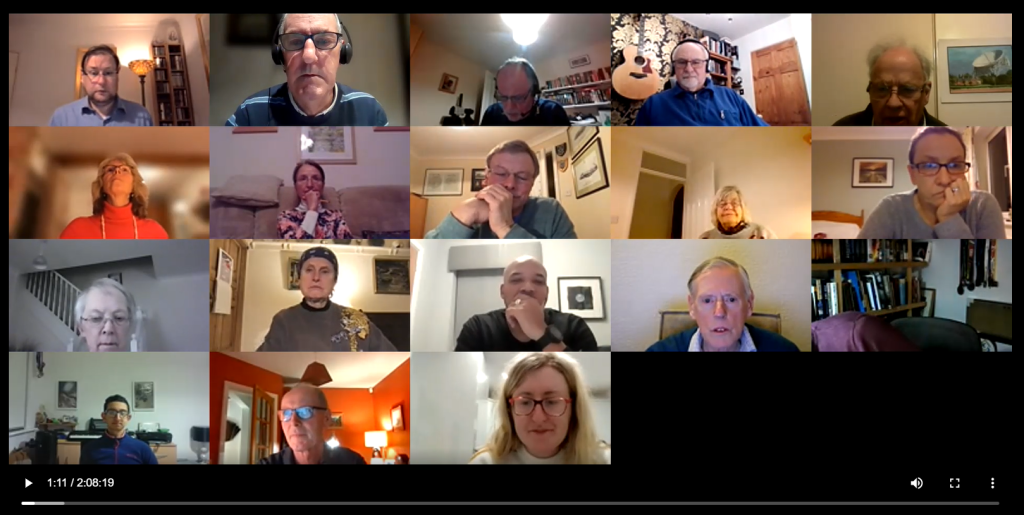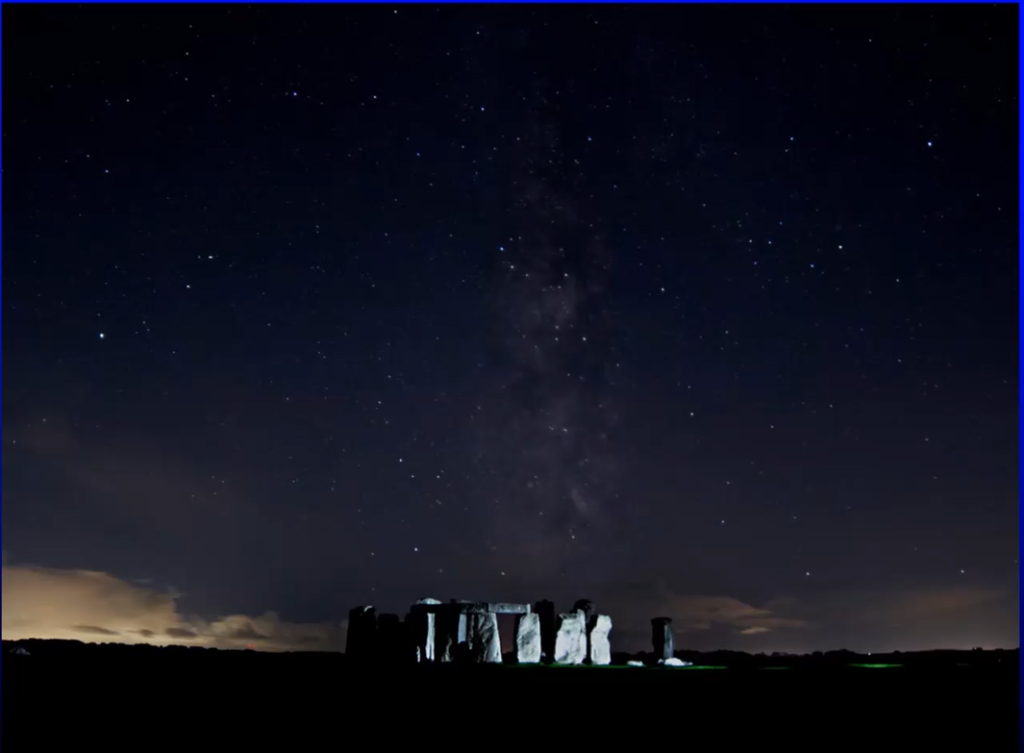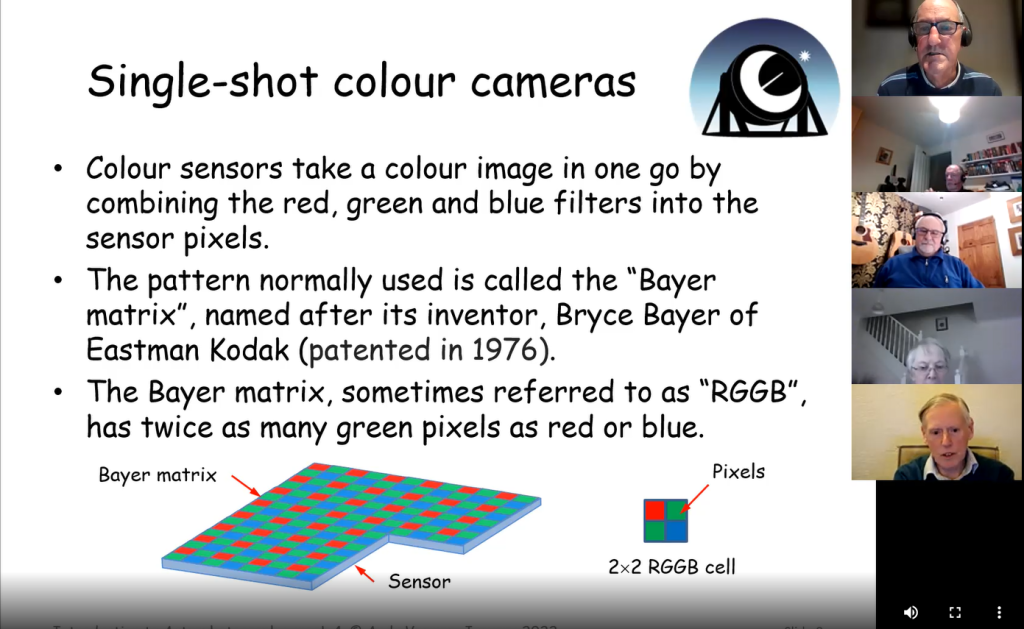Macclesfield Astronomical Society regularly runs evening classes for its members. Over the last two years MaccAstro has run the following courses:
- Introduction to Astronomy evening class, run by Malcolm Beesley
- Introduction to Astrophotography, run by Ian Morison and Andy Verwer
- Practical Observational Astronomy, run by Andy Verwer and Ian Morison
All courses are delivered over Zoom, so participants can join in from the comfort of their own home. All lessons are recorded, so people can catch up if they are unable to attend a class.
These courses are totally free for members and do not require any previous knowledge of astronomy or astrophotography, or ownership of equipment. For members that do not have their own binoculars or telescopes, MaccAstro has a number of instruments that can be loaned to members free of charge.
The courses all incorporate a significant amount of practical content including practical exercises, homework and field trips.

Introduction to Astronomy
This course is based on the GCSE astronomy syllabus, but assumes no prior knowledge other than having looked up in the sky and wondered? A few mathematical equations will be mentioned along the way, and these will serve as important tools to link together some pieces of the jig-saw but you will only need to recognise that these exist and that they can be very useful – this is not Astro-Physics.

Hopefully this course will serve as an introduction for those wishing to develop their interest in astronomy by joining the MaccAstro observing group or other courses.
Practical Observational Astronomy
This is an introductory evening class aimed at teaching the basics of practical observational astronomy. The course aims to give guidance on equipment and techniques for observing the heavens. The course includes a number of field trips if the weather is kind to us. Most classes will finish with an exercise or task which ideally needs to be completed before the next class. Completion of some exercises may not always be possible due to poor or cloudy weather. It is quite probable that some of the practical exercises will not be viable. Thus the proposed schedule will be interpreted with a great deal of flexibility.
Participants do not need to own a telescope or binoculars to undertake the practical part of the course. However, if you have a telescope or binoculars these can be used for some of the practical sessions that form part of the course. For those who do not own a telescope or binoculars, the Society has a number of instruments that can be lent to class attendees for the duration of the course.

The teaching schedule will be interpreted with a great deal of flexibility. Good weather may allow us to incorporate one or more class visit to Tegg’s Nose or other site in order to carry out some practical observation. If this happens then the teaching schedule may have to be modified.
The teaching schedule includes:
- Basic observational techniques, naked eye observation, dark adaption, use of averted vision, dealing with glasses. Use of red torches. Keeping warm and comfortable.
- Introduction to using telescopes and binoculars. MaccAstro equipment available for loan to participants.
- Planning your observation. Introduction to Stellarium. Practical exercises in locating stars, moon, planets and deep sky objects. “Seeing” and sky transparency.
- Night sky familiarization. Stars, planets and nebulae. Star atlases and planispheres. Constellations and asterisms. Guide to the night sky over the various seasons.
- Location of faint objects using star hopping.
- Finders and their adjustment. Types of telescope mounts, GOTO systems and polar alignment.
- Telescopes and eyepieces in detail. Magnification and field of view. Barlow lenses and reducers. Focussing aids.
- Lunar observation. Lunar phases and the terminator. Libration. “Clair Obscur” effects. Use of moon filters.
- Planetary observation. The inferior and superior planets. Opposition and conjunction. Planet sizes and phases. Location and visibility of planets. Features and moons of the planets.
- Observation of other objects: the sun, satellites, meteor showers and comets. Use of solar filters. Deep sky objects. The Messier, Caldwell and NGC catalogues.
Introduction to Astrophotography
This is an evening class aimed at people who wish to venture into astrophotography. The course is designed as a practical introduction to photography of the heavens for people who have a little basic knowledge of astronomy and photography. People who have some experience with basic astronomy and “normal” photography should be able to join the class. Those who have previously undertaken MaccAstro’s “Introduction to Astronomy” or “Practical Observational Astronomy” evening classes should be able to progress onto this course without difficulty.

Participants will need a digital camera (DSLR or mirrorless) and a tripod to undertake the practical part of the course but this can be obtained a few weeks into the course. You may also need to obtain an adaptor to allow your camera to be fitted to a telescope, if you have the use of one.

A telescope is not necessary, but if you have a telescope and mount these can be used for some of the practical sessions that form part of the course. For those who do not own a telescope or mount, the Society has a number of instruments that can be lent to class attendees. It is essential that attendees have a PC or laptop for image processing. You will need to install various software packages for the practical exercises.
For some exercises we will distribute previously captured images for you to work on. You will need to install some software for image processing. Most of this software is free and can be downloaded without charge. However, some software is only available for a fee. One such example is “Affinity Photo” which is a licensed package available for less than £50 and should be purchased as much of the image processing will be done using it. (At times it is on offer for about £30.)
The teaching schedule includes:
- An overview of image processing software used on the course. Installation of software for the course. Introduction to cameras, lenses and telescopes.
- Introduction to Affinity Photo. Personas, adjustments, layers and filters. Histograms and image stretching. Plugins and Macros. File formats: RAW, TIFF, JPEG, etc. Colour depth. Exercises in cropping, stretching, combining and converting images.
- Star trail images. Use of an intervalometer. Stacking images to produce a star trail image using StarStax and Affinity Photo. Removing Light Pollution. Capturing an image of a constellation. Exposure control; the “500” rule and associated star trailing estimation. Use of Deep Sky Stacker to combine exposures.
- Camera sensors, sizes and resolution. Mono and colour sensors, the Bayer filter matrix. Field of view and resolution calculations for a simple telescope + camera combination. Practical methods of attaching cameras to telescopes. Blackwater Skies Field of View Calculator. Camera sensitivity, ISO and gain, image noise, sensor cooling. Use of calibration frames.
- Capturing deep-sky objects. Aperture and focal length considerations. Star trackers and their use to allow longer exposures to be taken .
- Imaging the moon and planets. Exposure and aperture considerations. Movie vs still capture. Seeing and lucky imaging. Introduction to “AutoStakkert!” for processing images and video sequences. Introduction to Image Composite Editor to combine lunar image segments.
- Changing the field of view. Eyepiece projection, Barlow lenses, extenders and reducers. Focussing aids. Mounts drives, tracking and GOTO systems. Alt-Az and equatorial mounts. Polar alignment. Use of SharpCap for polar alignment. Guide scopes, ASCOM drivers and introduction to PHD2.
- Preparing for imaging. Use of Stellarium and star atlases to find best time to image deep sky objects and planets. Plate solving to help locate faint and small objects.
- Filters, broad band and narrow band. Light pollution, the Bortle scale. Filters for emission nebulae. Filters for colour cameras and mono cameras. The Hubble palette.
- Advanced techniques in Affinity Photo and ImagesPlus. Removing star trails. Binning, drizzling and dithering. Deconvolution.
- Imaging the Sun, comets. Capturing meteor trails. Photographing aurora.